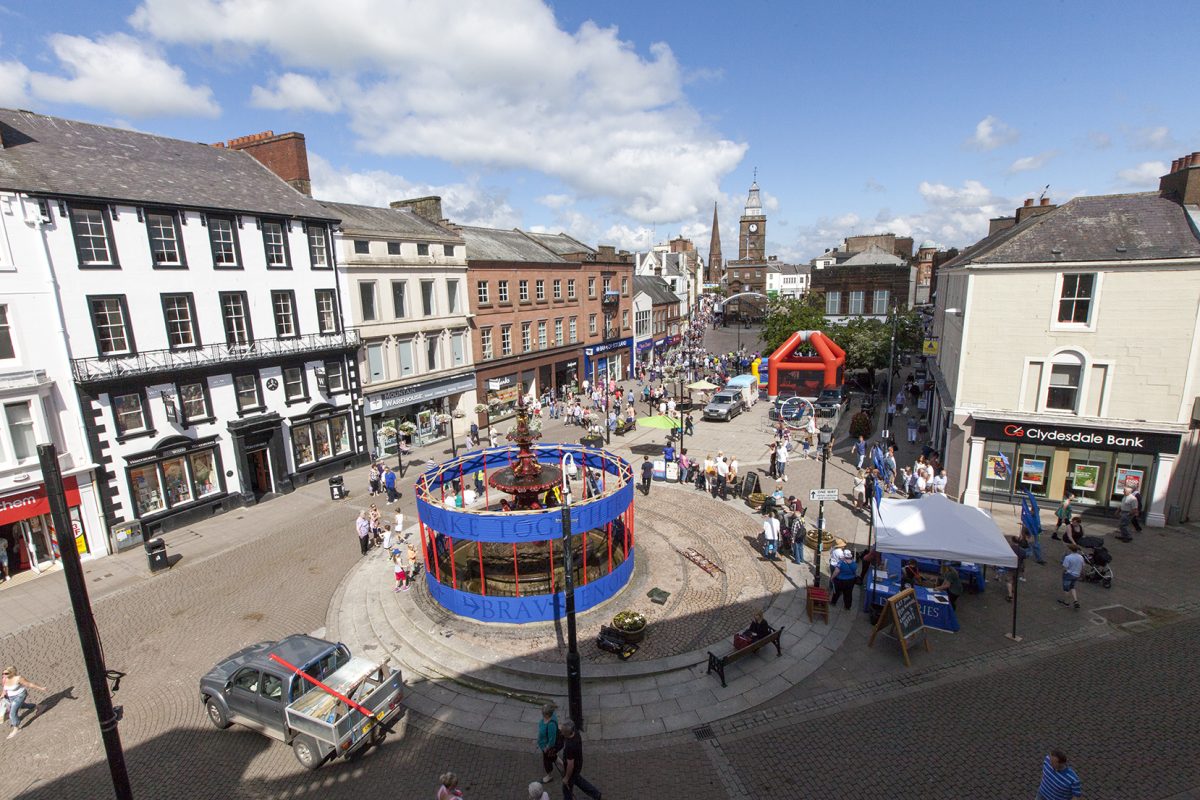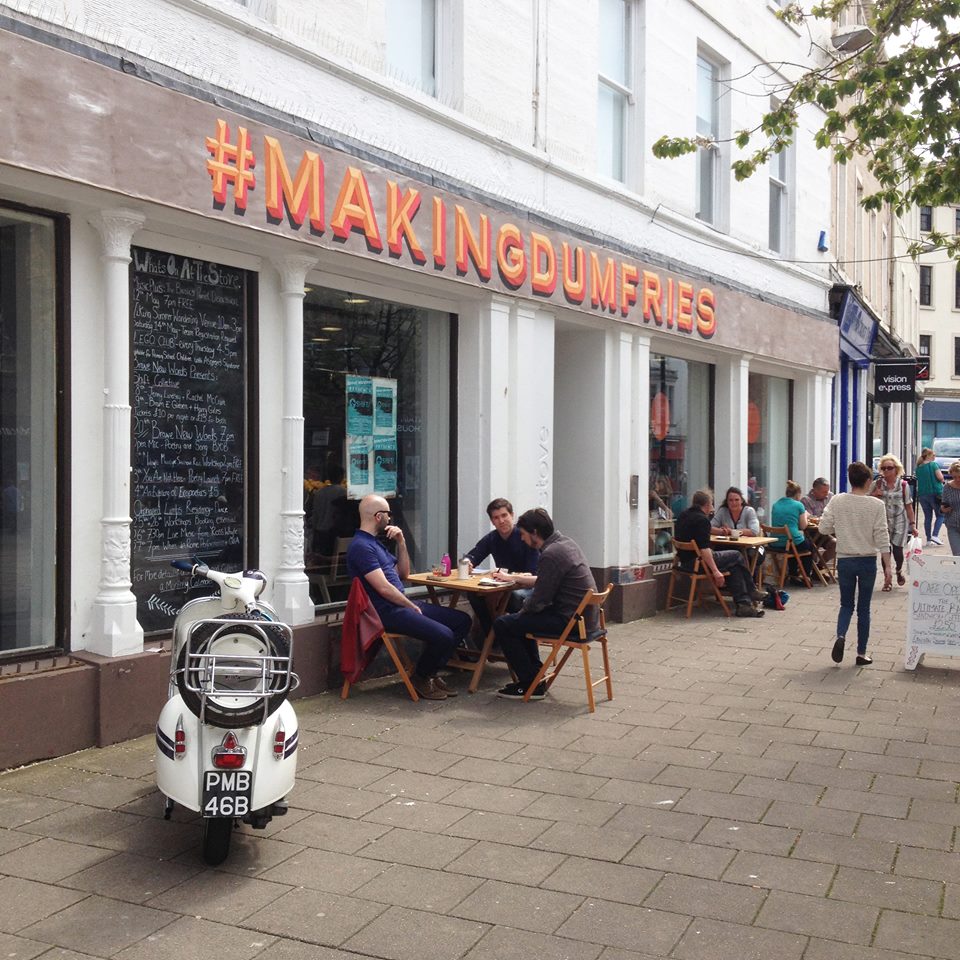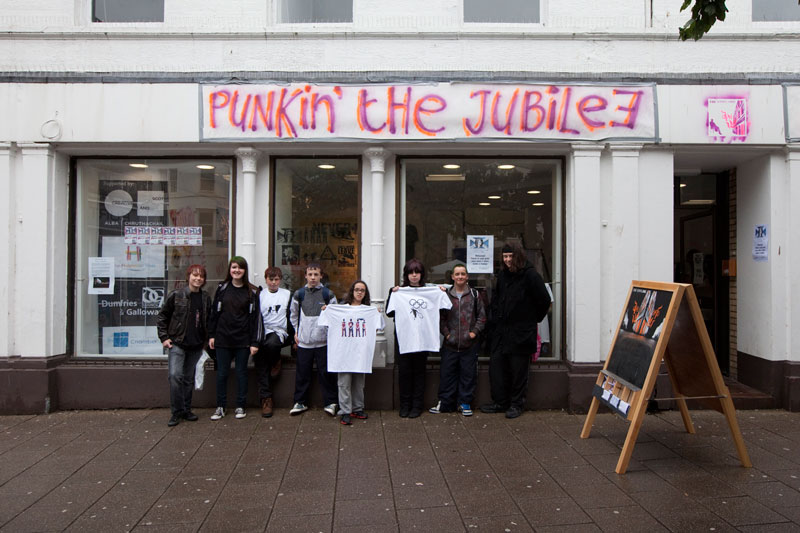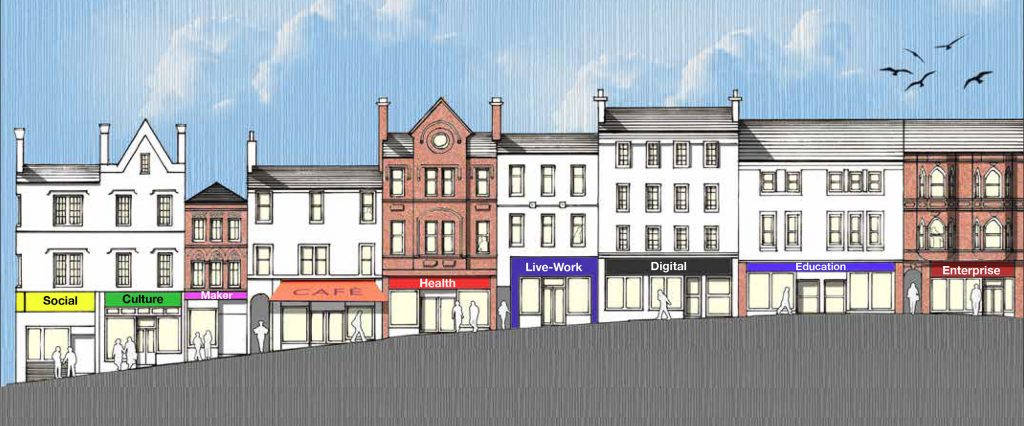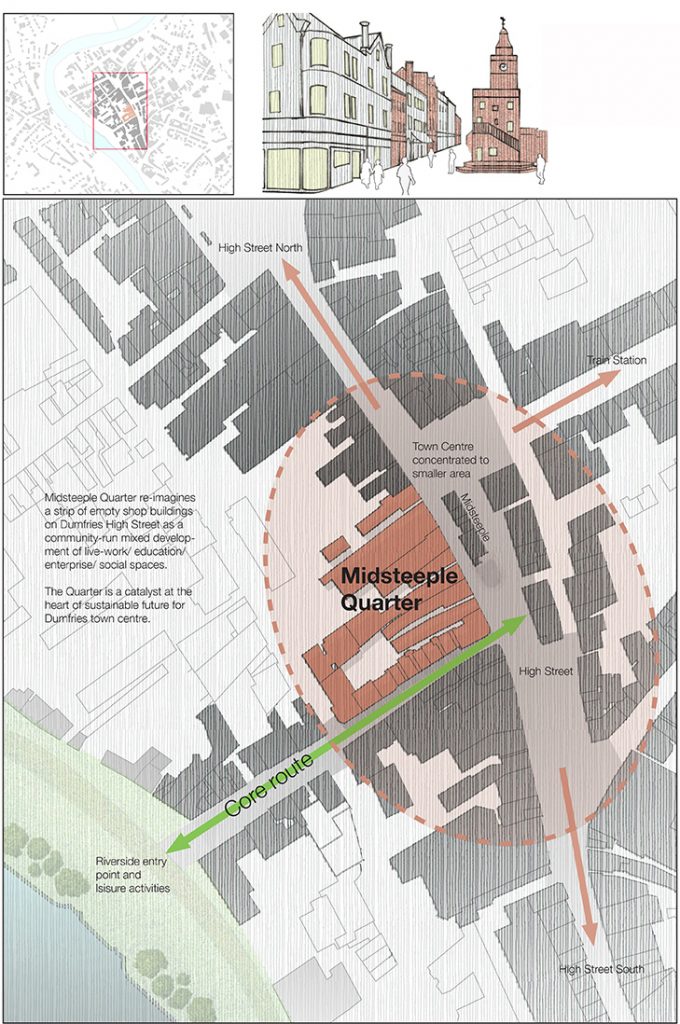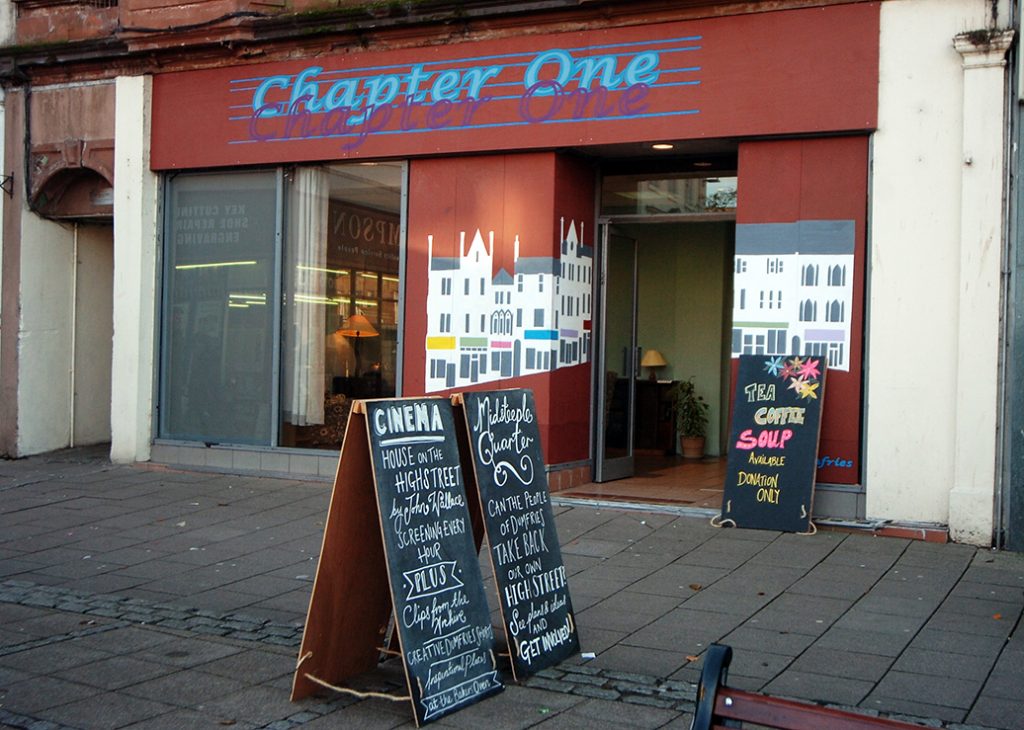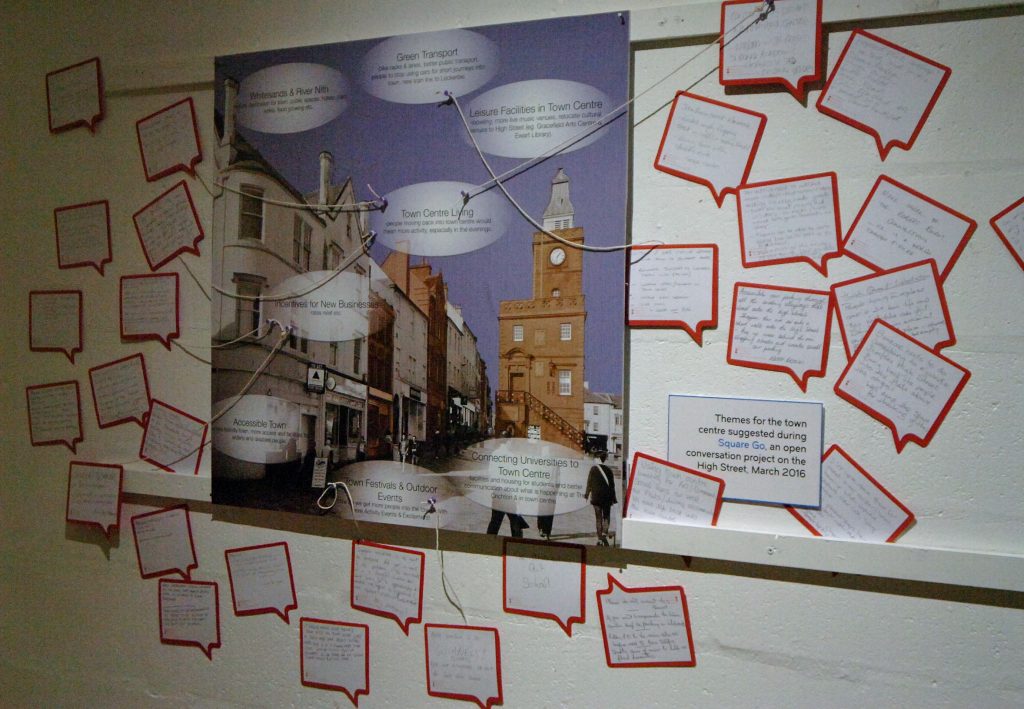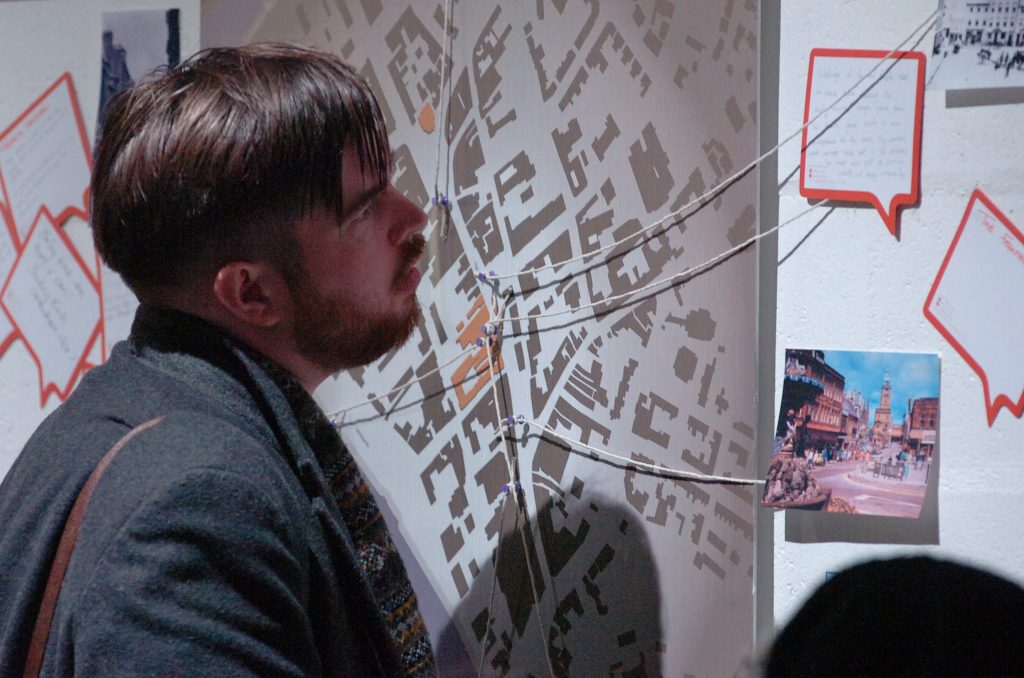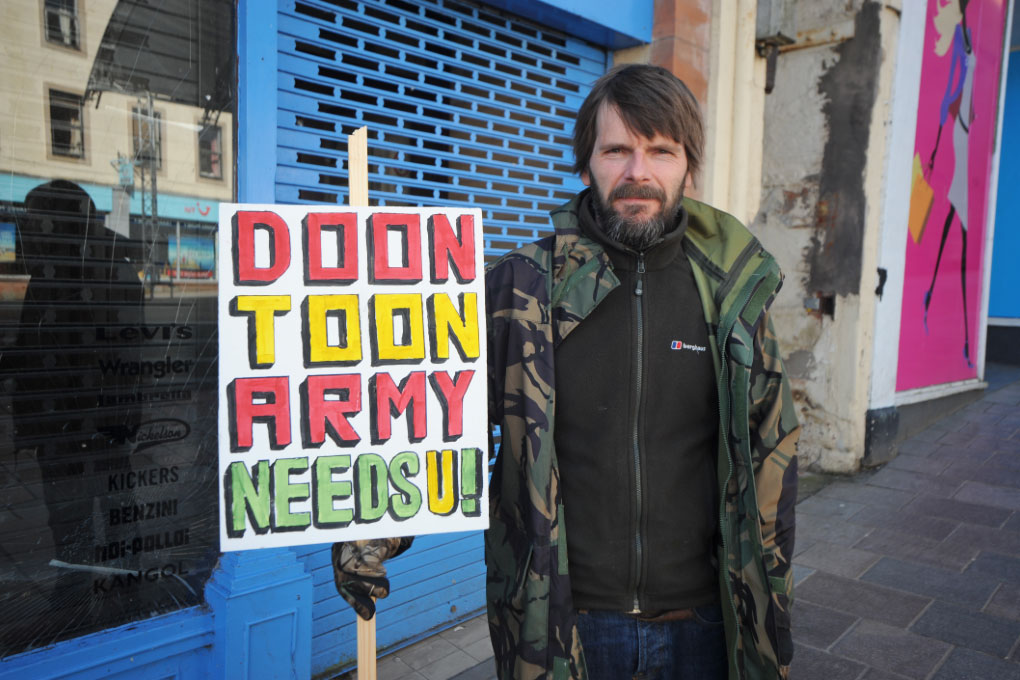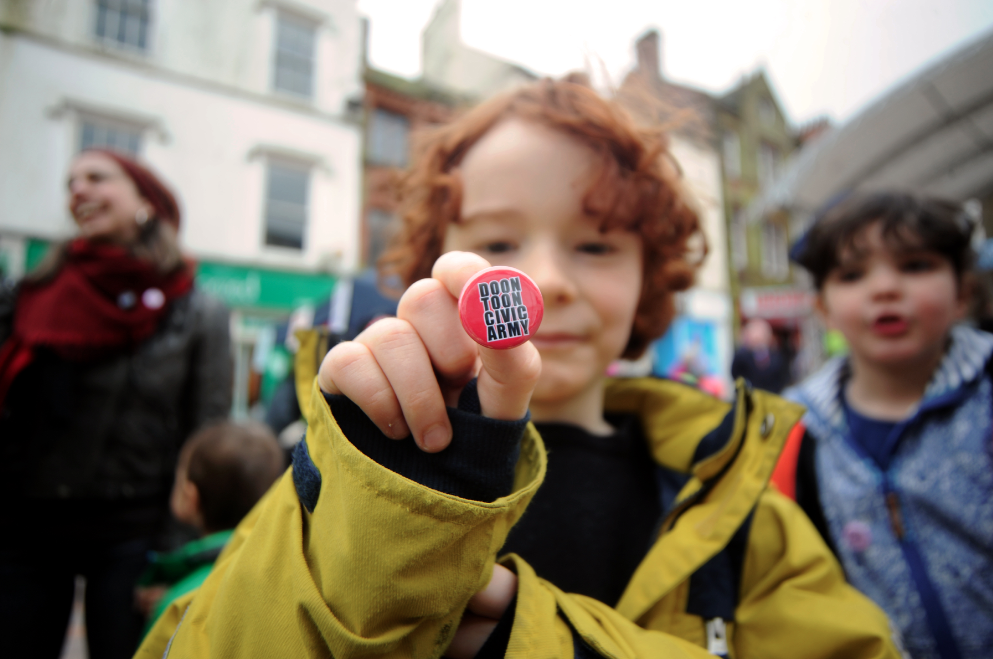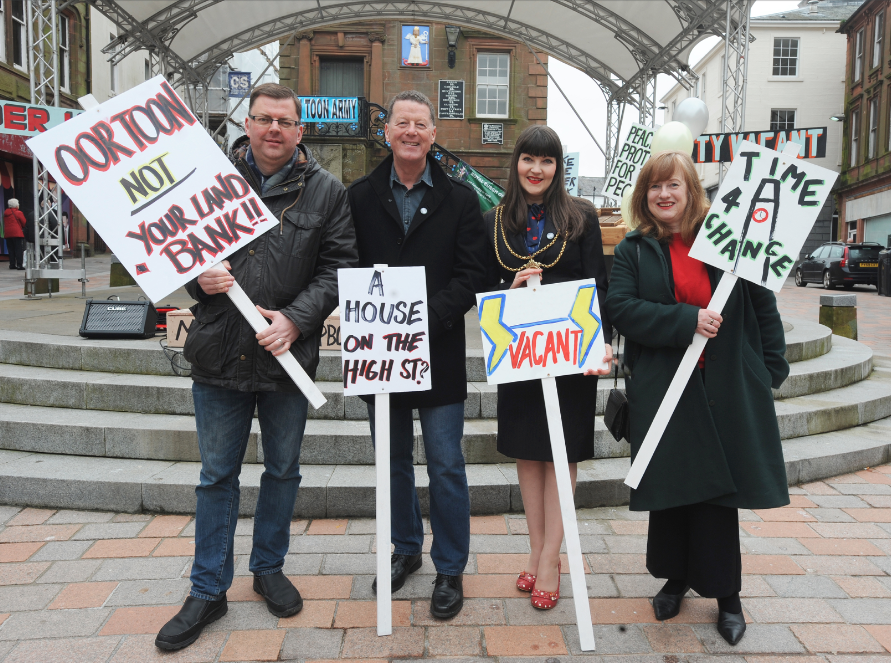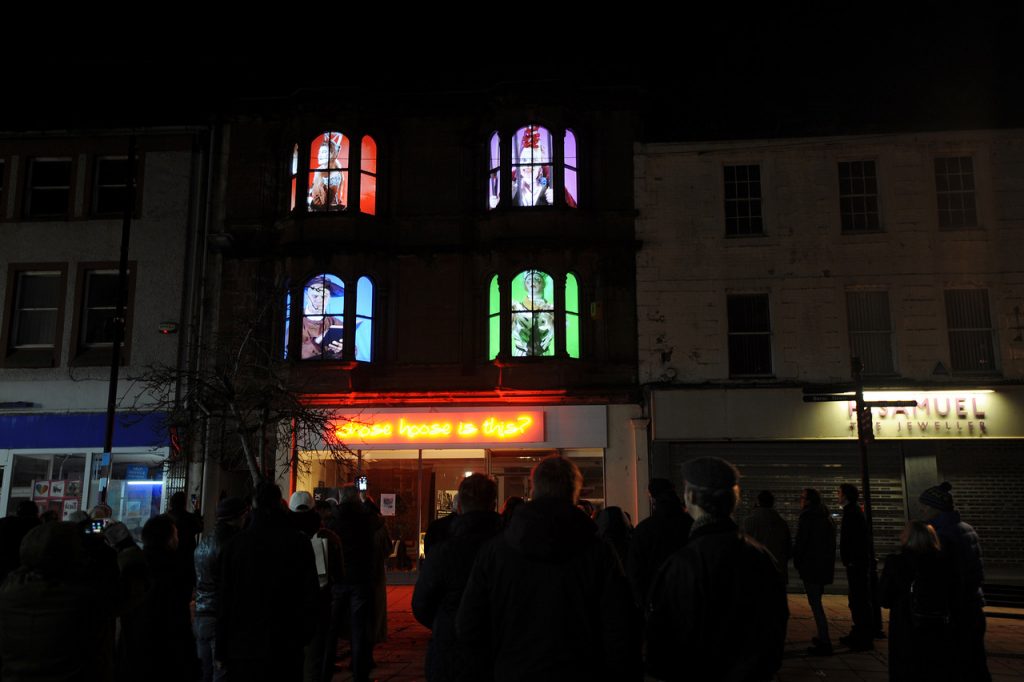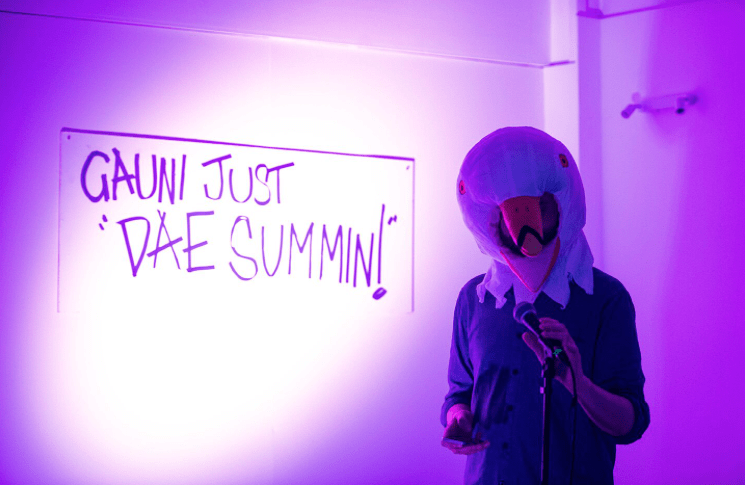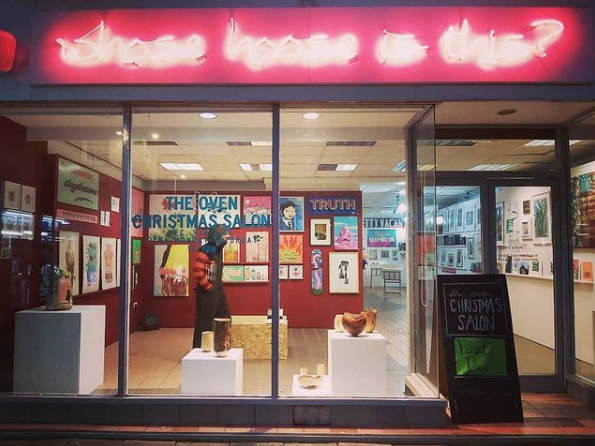The Stove and the Town Centre
In this section, we share the history of the Stove’s relationship with the town centre, the evolving future, and the role that the Stove plays alongside our partners and collaborators at the Midsteeple Quarter and other local organisations to bring life and creative activity back to the centre of Dumfries.
Use the accordion feature below to expand each section to read the details:
The Beginnings
The Stove Network was started, in 2011, by a group of local creative practitioners who had an idea that creativity could play a part the future of Dumfries town centre. The High Street was already in decline and members of the group had practical experience of projects that had helped bring vibrancy, confidence and partnership working to other places around the country – they wanted to see what they could do for their home town. The key idea of The Stove was that its agenda should be driven by local people – first and foremost The Stove set out to be a place that was accessible to everyone, somewhere that listened and somewhere with run by people who saw their role to facilitate and add value to the ideas people brought to The Stove.
The first part of The Stove’s process was ‘invitation’ – public events and collaborative projects with local groups explored attitudes to the identity of the town. These activities were always hands-on and participative – people were part of making them rather than passive spectators – these activities made a space for the exchange of ideas and always contained an inherent question: ‘what is important about Dumfries and what should a future Dumfries be like?’
From the conversations over the first year or so – it became clear that the most pressing issue for people was the state of the town centre itself. It was a matter of deep personal concern that the town centre was no longer somewhere that was a source of pride – it is a crisis of identity for a place when its people are no longer proud to show it off to visitors. The identity of Dumfries town centre, it seemed was part of the personal identity of its inhabitants and people felt gloomy and disempowered by the state of the town. The idea of disempowerment manifested itself as the oft repeated opinions that ‘someone else is in charge of the town’ (usually ‘the council’), which led to the feeling that ‘there is no point trying to do anything’.
This early work set an agenda and a way of working for The Stove of:
- To create opportunities for people to do things for themselves and see the effects of that.
- To involve people and organisations seen as ‘having power’ and use our work as a platform for people to come into contact with power and demystify decision-making and how things get done in our community
- To focus our work around developing a community-led vision for the town centre – at both a strategic level and through practical action through starting groups and initiatives.
From here on the focus of the question The Stove asked with its projects became ‘What should the future of Dumfries look like and how could you be involved in making this happen’.
One outcome of this activity was that The Stove itself became part of the re-imagining of Dumfries, as it became a place associated with energy and vibrancy. The Stove became the place you when to find out what was going on and to be part of it – it became the centre of gravity for the regions’ creative sector and created jobs and learning opportunities for many people, particularly young people and the activity and opportunities around The Stove encouraged many younger people to return to the region after higher education courses away from home.
Another outcome was a growing consensus around the kind of Dumfries that people would like to make. This was a vision of a mixed town centre, one not solely dependent on retail, but also including places to learn, services, leisure, culture and enterprise. Somewhere that new local businesses could start and grow and, crucially, somewhere that was built around principles of community wealth building and retained the prosperity it generated for the local population. The benefits of this new vision were not solely economic, but social and environmental – people wanted a town that was diverse and welcoming for families, older people and people with disabilities – somewhere that everyone felt a part of, that made them feel good and that actively championed more sustainable living. Any such plan requires a priority of action and in our case the priority was identified as beinging people back to live in the town centre. Dumfries was depopulated with only one family as long-term residents on the High Street. More residents were seen as leading to a nighttime economy, safer streets, environmental benefits through people living closer to work and services and giving up cars and overwhelmingly a sense that of identity and community to the town centre.
A House on the High Street
Seeing this direction emerge The Stove commissioned local filmmaker John Wallace to create a documentary about the evolving story of the High Street and why people didn’t live there anymore. This film was called A House on the High Street, and it was shown running on a loop for 2 weeks at The Stove.
Following this, John Dowson, a local resident approached The Stove to ask if they could stage a special screening and invite some local ‘movers and shakers’. John had been moved by the film’s story of depopulation of the town centre and hoped that sentiment could encourage people to take action.
At the end of the screening the audience of councillors, housing associations, heritage people, architects etc looked out of the window and made a resolution to ‘get people living in 107-109 High Street’ (107-109 is the most prominent empty building near the iconic Midsteeple building). This was the beginning of the idea of Midsteeple Quarter as a community-led regeneration project to breathe life back into the town centre.
The Beginnings of a Midsteeple Quarter
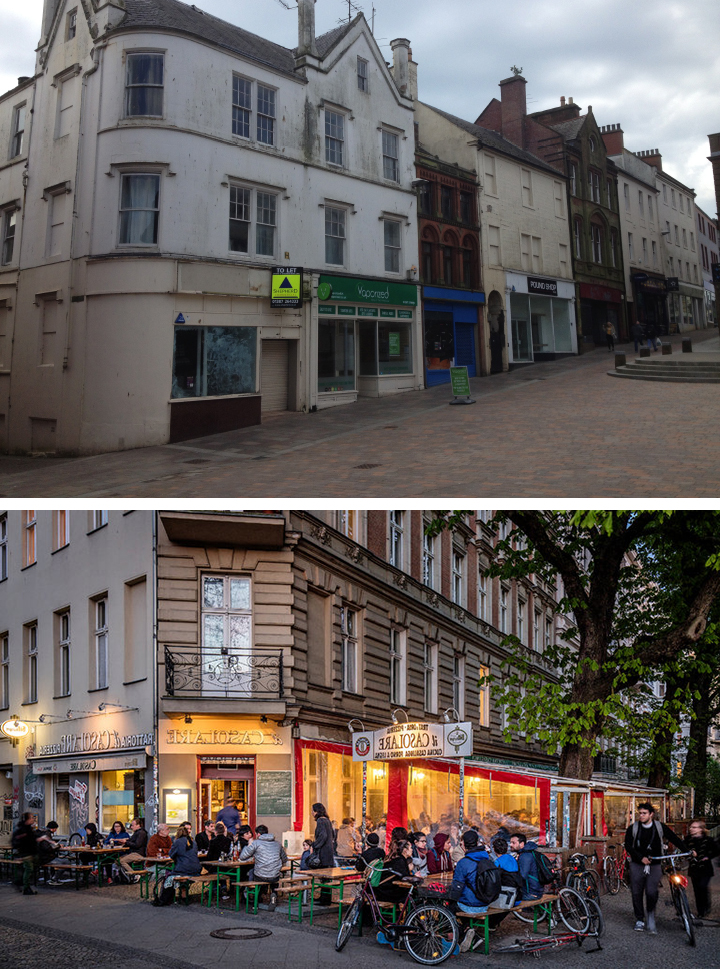
Various local people convened around The Stove to develop the vision of Midsteeple Quarter and the initial idea grew to include a whole town block defined by a row of 8 underused High Street buildings – each of these has a long footprint which reaches back into the block defined by High Street and Irish Street. The core of the vision was for the community to develop this block as a demonstration of the kind of mixed town centre local people wanted and initial design works suggested that high-quality rented housing for up to 200 people could be created in Midsteeple Quarter.
This visioning work was taken back to the people for their feedback at an event called ‘Chapter One’ where one of the buildings in the Midsteeple Quarter was temporarily converted into the living room of a flat and design ideas were exhibited alongside matchstick models of town centre buildings made by Frank Brown and regular screenings of ‘A House on the High Street’. The two day event was attended by over 500 people many of whom signed up to ‘The Dumfries Pledge’ to be an active part of making these ideas become a reality.
Following the success of Chapter One, The Stove raised some funding to stage a national architectural design competition which asked designers to put forward ideas for how the Midsteeple Quarter could be developed. Over 20 Scottish practices entered the competition, which was co-produced with the Glasgow Institute of Architects. The designs were exhibited at The Stove and people were invited to vote for their ‘people’s choice’ (the result of the vote was the same as the judge’s winner – Gordon Fleming of ARPL architects in Ayr). The designs were also exhibited in Glasgow with a well-attended discussion event on town centre regeneration.
Throughout this work The Stove was well supported with advice from national agencies such as Development Trust Association Scotland, Community Land Scotland, Scotland’s Towns Partnership, SURF (Scotland’s Regeneration Agency) and Scottish Communities Alliance. The Stove became the first Development Trust in the UK to be led by artists and won the Creative Regeneration category of the Scottish Regeneration Awards in 2016.
Midsteeple Quarter: A Community Benefit Society
The idea of a community led regeneration project called “Midsteeple Quarter” was also receiving enthusiastic support from Dumfries and Galloway Council and Scottish Government who saw the project as a key national example of community-led regeneration in an urban context and an example that could be followed by the many other Scottish towns that were struggling due to the downturn in High Street retail. DG Council gave a grant to The Stove for the “Midsteeple Quarter project” of £100,000 form their ‘Town Centre Living Fund’ to support the development of business planning and a Community Asset Transfer for 135-139 High Street (the northernmost building within Midsteeple Quarter), funds were provided to help set up a new community organisation to take the project forward.
By this stage more than 200 people had signed The Dumfries Pledge and everyone involved felt there was sufficient support for the “Midsteeple Quarter” idea to start a Community Benefit Society to carry forward the project. A Community Benefit Society is a form of organisation that is 100% community controlled and akin to a traditional ‘mutual’ or ‘building society’ its members are all part owners of everything the organisation owns and does.
In April 2018 The Stove produced a public launch for the Midsteeple Quarter Community Benefit Society. Designed by artist Kevin Reid it featured protest signs, a public soapbox for speeches and street entertainers. With over 150 people signing up that first day, the organisation was well on it’s way and has over 500 members at the time of writing (March 2021).
Through the early stages of the Community Benefit Society, The Stove continued to support the development of Midsteeple Quarter by funding initiatives like the Creative Producer project which curated events in 135-139 High Street and Stove Orchestrator Matt Baker continued to lead the project until February 2020 – Matt led the development of the Midsteeple Quarter ‘Blueprint’ the asset transfer of 135-139 High Street, fundraising £3M for its redevelopment and sourcing revenue funding for a project team to continue the delivery of Midsteeple Quarter. The Stove have a seat on the Midsteeple Quarter board and The Stove and Midsteeple Quarter continue to collaborate on joint projects working towards their shared vision of a locally-led and diverse town centre that truly supports the needs and aspirations of everyone in our community. With MSQ forging ahead with physical regeneration in the town centre and The Stove focussing on community development and creating activity and enterprise.
As of April 2021 Midsteeple Quarter has brought 5 High Street buildings into community ownership and has started on site with the re-development work for 135-139 High Street (Phase One). Phase One will comprise 6 new two-bedroom flats for rent and 350 sq m of enterprise space to support the growth of new businesses in the town centre. Midsteeple Quarter is also supporting new businesses through provision of short-medium ‘meanwhile spaces’ in other buildings they own prior to re-development. Midsteeple Quarter has a high-quality professional team to deliver their work under the direction of an established board that is elected annually by the membership pf the Community Benefit Society.
Case Studies
Carnegie Trust UK: Turnaround Towns report: “The Stove and the Midsteeple Quarter.”
London School of Economics: Power to Change: Saving the High Street – The Community Take Over
Architecture and Design Scotland: Learning from Midsteeple Quarter (animation)
Community Land Scotland: Midsteeple Quarter Dumfries High Street (video)
The Stove and the Town Centre: An Evolving Story
While following the creative process to arrive at a community vision and methodology for future town centre, the activities of The Stove had associated impacts. In itself, The Stove became part of the revitalisation of Dumfries town centre, the building at 100 High Street became a hub that people gravitated for to find out what was happening and to become part of a momentum of change. In particular, The Stove became a regional centre for the creative sector, a place where people could gain skills and experience, somewhere where you could find employment and develop career paths that previously were not available locally. The values of The Stove centre around accessibility and equality and it has been a feature of The Stove’s approach to make opportunities available to everyone in our community.
As the Midsteeple Quarter project has developed and become independent of The Stove we have continued to work in collaboration with Midsteeple Quarter, we have a Memorandum of Understanding between us, towards our shared vision of a locally-led and diverse town centre that truly supports the needs and aspirations of everyone in our community. With Midsteeple Quarter forging ahead with physical regeneration in the town centre and The Stove focusing on community development and creating activity and enterprise.
Midsteeple Quarter is one of the very many organisations, groups and agencies that The Stove works with in partnership in our new mission of supporting our community to ‘grow its own culture’ and helping them to develop the skills and capacity to do this.
A key concept around the current Stove approach is ‘Creative Placemaking’ – the role of creativity and creative practice in initiating and sustaining community-led initiatives and social enterprises which improve social, economic and environmental outcomes for places and people. Creative Placemaking is explicitly addressed in The Stove’s ‘Embers’ project which explores ‘Creative Placemaking in the South of Scotland’ and puts forward a vision of an empowered network of creative placemaking practice across the region which shares knowledge, capacity and resources to grow the region as a powerhouse of creative industries, innovation and social enterprise.
The Stove’s Culture Collective Project – ‘What We Do Now’ is a pilot project for the Embers approach and sees The Stove supporting 5 towns in Dumfries and Galloway to develop creative placemaking initiatives.
Other projects within The Stove’s Creative Placemaking approach are:
1. Community Visioning Work
- Dynamically Different Dumfries – The Stove is a founder member of the Dumfries Partnership Action Group who are leading on the development of a community action plan for Dumfries town centre
- Ongoing work with Midsteeple Quarter, such as our recent project ELSEWHERE.
- Working with Dumfries and Galloway Council on a regional culture strategy
- Conversing Building – using physical space as a medium to communicate ideas with our community
2. Learning and Skills Work
- Soapbox – Covid transition skills programme for creative sector
- Creative Spaces and Pathways – support projects for creative people between 18-30
- Brave New Words – support platform for self-expression
3. Supporting the development of new initiatives, organisations and groups
- Midsteeple Quarter
- Dumfries Music Conference
- Environmental Arts Festival Scotland
- D-Lux Festival of Light
- High Street Writers
- Creative Futures
- LIFT D+G
- For Enjoyment CIC
- Lavender Menace
- Dumfries Fountain Restoration Project

